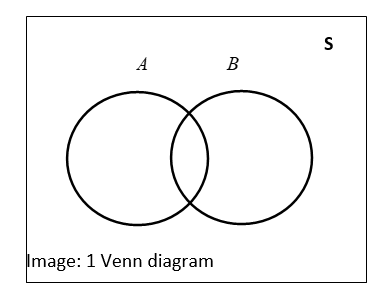
If $A$ and \[B\] are two events, then \[P(A\cup B)=\]
A. \[P(A)+P(B)\]
B. \[P(A)+P(B)+P(A\cap B)\]
C. \[P(A)+P(B)-P(A\cap B)\]
D. \[P(A)\cdot P(B)\]
Answer
220.2k+ views
Hint: In this question, we are to find the probability of the union of two events. This is nothing but proof of the addition theorem on probability. By using set theory, the required probability is calculated.
Formula Used:The probability is calculated by,
\[P(E)=\dfrac{n(E)}{n(S)}\]
\[n(E)\] - favourable outcomes and \[n(S)\] - sample.
According to set theory,
the Union of sets is described as
\[A\cup B=\{x/x\in A\text{ or }x\in B\}\]
Intersection of sets is described as
\[A\cap B=\{x/x\in A\text{ and }x\in B\}\]
Symmetric difference is described as
\[\begin{align}
& A-B=\{x/x\in A\text{ and }x\notin B\} \\
& B-A=\{x/x\in B\text{ and }x\notin A\} \\
\end{align}\]
If there are two events in a sample space, then the addition theorem on probability is given by
\[P(A\cup B)=P(A)+P(B)-P(A\cap B)\]
Complete step by step solution:Consider two events $A$ and \[B\].
These events are shown by the Venn diagram as below:

From the diagram, we have
\[\begin{align}
& A\cup B=S \\
& (B-A)\cup (A\cap B)=B \\
& (B-A)A\cap (B-A)=\Phi \\
& A\cup (B-A)=A\cup B \\
& A\cap (A\cap B)=\Phi \\
\end{align}\]
Then, from these we can apply probability on \[(B-A)\cup (A\cap B)=B\] and \[A\cup (B-A)=A\cup B\].
Applying probability to \[(B-A)\cup (A\cap B)=B\]:
\[\begin{align}
& (B-A)\cup (A\cap B)=B \\
& P(B)=P\left[ (B-A)\cup (A\cap B) \right] \\
& \text{ }=P(B-A)+P(A\cap B) \\
& \Rightarrow P(B-A)=P(B)-P(A\cap B)\text{ }...(1) \\
\end{align}\]
Applying probability to \[A\cup (B-A)=A\cup B\]:
\[\begin{align}
& A\cup (B-A)=A\cup B \\
& P(A\cup B)=P\left[ A\cup (B-A) \right] \\
& \text{ }=P(A)+P(B-A) \\
\end{align}\]
On substituting (1), we get
\[P(A\cup B)==P(A)+P(B)-P(A\cap B)\]
Thus, the addition theorem on probability is proved.
Option ‘C’ is correct
Note: Here we may go wrong with the set theory formula. If the Venn diagram is used, then the formulae will be established easily. Then, by applying the probability to the sets, the required addition theorem on probability is obtained.
Formula Used:The probability is calculated by,
\[P(E)=\dfrac{n(E)}{n(S)}\]
\[n(E)\] - favourable outcomes and \[n(S)\] - sample.
According to set theory,
the Union of sets is described as
\[A\cup B=\{x/x\in A\text{ or }x\in B\}\]
Intersection of sets is described as
\[A\cap B=\{x/x\in A\text{ and }x\in B\}\]
Symmetric difference is described as
\[\begin{align}
& A-B=\{x/x\in A\text{ and }x\notin B\} \\
& B-A=\{x/x\in B\text{ and }x\notin A\} \\
\end{align}\]
If there are two events in a sample space, then the addition theorem on probability is given by
\[P(A\cup B)=P(A)+P(B)-P(A\cap B)\]
Complete step by step solution:Consider two events $A$ and \[B\].
These events are shown by the Venn diagram as below:

From the diagram, we have
\[\begin{align}
& A\cup B=S \\
& (B-A)\cup (A\cap B)=B \\
& (B-A)A\cap (B-A)=\Phi \\
& A\cup (B-A)=A\cup B \\
& A\cap (A\cap B)=\Phi \\
\end{align}\]
Then, from these we can apply probability on \[(B-A)\cup (A\cap B)=B\] and \[A\cup (B-A)=A\cup B\].
Applying probability to \[(B-A)\cup (A\cap B)=B\]:
\[\begin{align}
& (B-A)\cup (A\cap B)=B \\
& P(B)=P\left[ (B-A)\cup (A\cap B) \right] \\
& \text{ }=P(B-A)+P(A\cap B) \\
& \Rightarrow P(B-A)=P(B)-P(A\cap B)\text{ }...(1) \\
\end{align}\]
Applying probability to \[A\cup (B-A)=A\cup B\]:
\[\begin{align}
& A\cup (B-A)=A\cup B \\
& P(A\cup B)=P\left[ A\cup (B-A) \right] \\
& \text{ }=P(A)+P(B-A) \\
\end{align}\]
On substituting (1), we get
\[P(A\cup B)==P(A)+P(B)-P(A\cap B)\]
Thus, the addition theorem on probability is proved.
Option ‘C’ is correct
Note: Here we may go wrong with the set theory formula. If the Venn diagram is used, then the formulae will be established easily. Then, by applying the probability to the sets, the required addition theorem on probability is obtained.
Recently Updated Pages
Mutually Exclusive vs Independent Events: Key Differences Explained

Area vs Volume: Key Differences Explained for Students

Geometry of Complex Numbers Explained

Electricity and Magnetism Explained: Key Concepts & Applications

JEE Energetics Important Concepts and Tips for Exam Preparation

JEE Isolation, Preparation and Properties of Non-metals Important Concepts and Tips for Exam Preparation

Trending doubts
Understanding Centrifugal Force in Physics

JEE Main Marking Scheme 2026- Paper-Wise Marks Distribution and Negative Marking Details

Understanding Entropy Changes in Different Processes

Common Ion Effect: Concept, Applications, and Problem-Solving

What Are Elastic Collisions in One Dimension?

Understanding Geostationary and Geosynchronous Satellites

Other Pages
JEE Advanced Weightage 2025 Chapter-Wise for Physics, Maths and Chemistry

Understanding Excess Pressure Inside a Liquid Drop

Understanding Elastic Collisions in Two Dimensions

Devuthani Ekadashi 2025: Correct Date, Shubh Muhurat, Parana Time & Puja Vidhi

Quadratic Equation Questions with Solutions & PDF Practice Sets

Difference Between Exothermic and Endothermic Reactions: Key Differences, Examples & Diagrams




